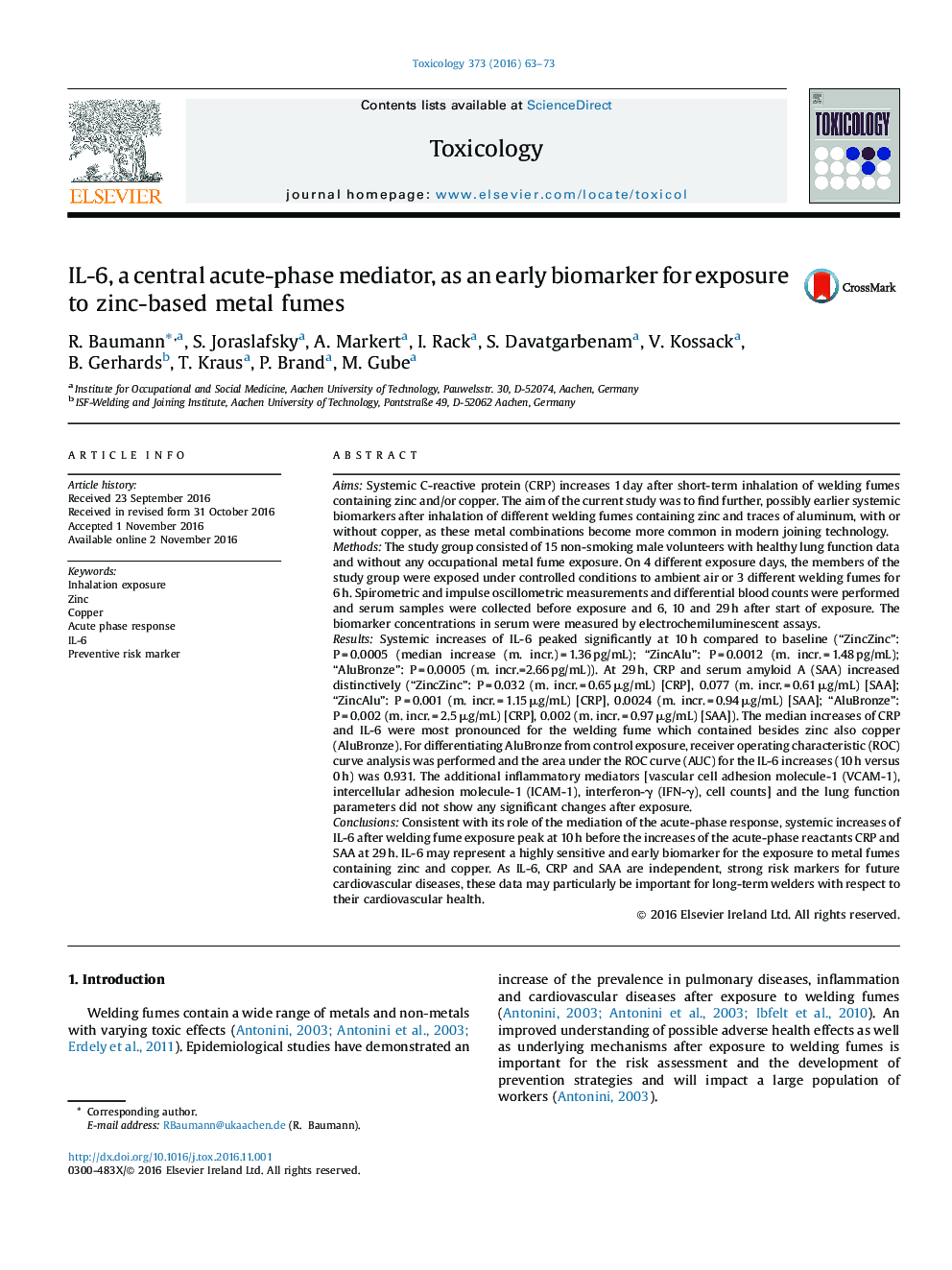| Article ID | Journal | Published Year | Pages | File Type |
|---|---|---|---|---|
| 5561904 | Toxicology | 2016 | 11 Pages |
AimsSystemic C-reactive protein (CRP) increases 1 day after short-term inhalation of welding fumes containing zinc and/or copper. The aim of the current study was to find further, possibly earlier systemic biomarkers after inhalation of different welding fumes containing zinc and traces of aluminum, with or without copper, as these metal combinations become more common in modern joining technology.MethodsThe study group consisted of 15 non-smoking male volunteers with healthy lung function data and without any occupational metal fume exposure. On 4 different exposure days, the members of the study group were exposed under controlled conditions to ambient air or 3 different welding fumes for 6 h. Spirometric and impulse oscillometric measurements and differential blood counts were performed and serum samples were collected before exposure and 6, 10 and 29 h after start of exposure. The biomarker concentrations in serum were measured by electrochemiluminescent assays.ResultsSystemic increases of IL-6 peaked significantly at 10 h compared to baseline (“ZincZinc”: P = 0.0005 (median increase (m. incr.) = 1.36 pg/mL); “ZincAlu”: P = 0.0012 (m. incr. = 1.48 pg/mL); “AluBronze”: P = 0.0005 (m. incr.=2.66 pg/mL)). At 29 h, CRP and serum amyloid A (SAA) increased distinctively (“ZincZinc”: P = 0.032 (m. incr. = 0.65 μg/mL) [CRP], 0.077 (m. incr. = 0.61 μg/mL) [SAA]; “ZincAlu”: P = 0.001 (m. incr. = 1.15 μg/mL) [CRP], 0.0024 (m. incr. = 0.94 μg/mL) [SAA]; “AluBronze”: P = 0.002 (m. incr. = 2.5 μg/mL) [CRP], 0.002 (m. incr. = 0.97 μg/mL) [SAA]). The median increases of CRP and IL-6 were most pronounced for the welding fume which contained besides zinc also copper (AluBronze). For differentiating AluBronze from control exposure, receiver operating characteristic (ROC) curve analysis was performed and the area under the ROC curve (AUC) for the IL-6 increases (10 h versus 0 h) was 0.931. The additional inflammatory mediators [vascular cell adhesion molecule-1 (VCAM-1), intercellular adhesion molecule-1 (ICAM-1), interferon-γ (IFN-γ), cell counts] and the lung function parameters did not show any significant changes after exposure.ConclusionsConsistent with its role of the mediation of the acute-phase response, systemic increases of IL-6 after welding fume exposure peak at 10 h before the increases of the acute-phase reactants CRP and SAA at 29 h. IL-6 may represent a highly sensitive and early biomarker for the exposure to metal fumes containing zinc and copper. As IL-6, CRP and SAA are independent, strong risk markers for future cardiovascular diseases, these data may particularly be important for long-term welders with respect to their cardiovascular health.
